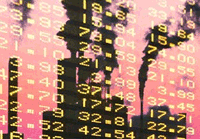
Global carbon market value hits record $176bn
Cologne, May 30, 2012
Carbon market trading reached a record value of $176 billion in 2011, rising 11 per cent spurred by secondary trading volumes which offset lower prices and slowing economies, the World Bank said on Wednesday.
Companies and governments are turning to emissions trading as a tool for fighting climate change, with the European Union by far the most active since its cap-and-trade scheme began in 2005.
A record number of emissions products were traded in 2011, even though prices of EU carbon permits and international offsets plumbed new depths well below $10 a tonne late in the year, the bank said in its annual report on carbon markets.
Worldwide emissions trading volume last year rose 17 per cent to 10.3 billion tonnes of carbon dioxide equivalent, with permits in the EU Emissions Trading Scheme (ETS) accounting for more than three quarters of the total.
The rise in volume lifted the value of the EU market to $148 billion from a revised $134 billion in 2010, despite average EU carbon prices falling 4 per cent year on year to $18.8 a tonne.
Carbon markets were not immune to global economic volatility prompted by the Arab Spring, Japan's Fukushima nuclear disaster and the euro zone debt crisis, the World Bank report said.
"A considerable portion of the trades is primarily motivated by hedging, portfolio adjustments, profit taking and arbitrage," it said.
But if carbon prices continue to remain below $10 a tonne there will be little incentive for companies and governments to invest in low-carbon projects, a bank official told reporters.
"There is a question over whether (prices) are high enough to support new projects coming in," said Alexandre Kossoy, senior financial specialist with the World Bank's Carbon Finance Unit.
He said carbon prices could rise if the EU agreed to toughen its 2020 emissions-reduction ambitions or took other policy measures to rebalance a massive oversupply of carbon units that is likely to last until 2020.
But front-year EU carbon prices are averaging under $10 a tonne so far this year, as the bloc's sluggish economy dampens demand for carbon permits in a market that analysts say has a surplus well into the hundreds of millions.
Other national and regional carbon schemes showed mixed results. New Zealand's carbon market value grew threefold to $351 million, while the Regional Greenhouse Gas Initiative in North America was nearly halved to $249 million, the bank said.
Secondary trading volumes for international offsets regulated by the United Nations also soared in 2011, rising 43 per cent year on year to 1.8 billion units valued at $23 billion.
The main reason for this was a rise in demand for UN-backed emissions offsets, because a certain number of the credits can be used for compliance in markets such as the EU ETS.
Average offset prices, which trade at a discount to EU carbon prices, fell 21 per cent year on year to $12.8 a tonne, as a record number of credits were issued last year.
The Clean Development Mechanism (CDM), which paves the way for investments in emission-reduction projects in developing nations, is the biggest offset market. It accounted for over 95 per cent of total spot and secondary emissions offset trading.
Direct pre-2013 CDM project-based transactions declined to under $1 billion in 2011 from $1.5 billion in the previous year as its 2008-2012 commitment period draws to an end.
However, primary investment in post-2012 CDM offsets, however, rose to nearly $2 billion in 2011 from $1.2 billion, despite depressed prices and uncertainty about the future of the Kyoto Protocol and its market mechanisms such as the CDM.
UN climate talks in South Africa last year agreed a package of measures that would extend Kyoto, a global pact enforcing carbon cuts, and decide a new, legally binding accord by 2015, coming into force by 2020.
The World Bank suggested recent and emerging cap-and-trade schemes in Australia, California, Mexico, South Korea and Quebec could contribute to future growth in overall carbon trading.
Primary project-based transactions in the voluntary offset market were valued at $569 million in 2011, up 37 percent, the bank said. - Reuters







